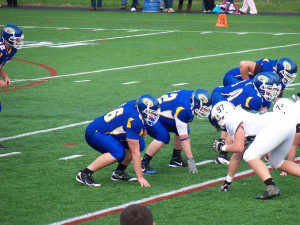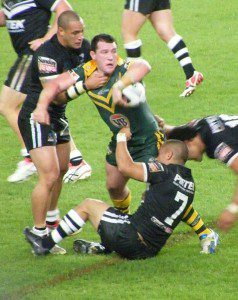
ALBANY, NY – We’re in the thick of the Heineken Cup, the HSBC Sevens Series and the NFL Playoffs and since I play offensive tackle for Western New England University, my dad was a rugby Prop and rugby is football’s papa, why not once again combine the two for my column? With that, here are five major comparisons between rugby and football. Since Sevens Rugby is target of the 2016 Olympic games and what is being introduced to the American TV audience, I’ll compare that game with the gridiron version.
1) Touchdowns vs Trys: A touchdown is a six-point play. A touchdown occurs when the player with the ball crosses the plane of the opposing team’s goal-line and gets into the try zone. This is equivalent to a try in rugby, which is a five-point score. The big difference? For a try in rugby, is you have to down the ball in the opposing team’s in-goal or try zone. This not required in football; a player scores and in most cases drops the ball and celebrates with their teammates… or the camera. If you did this in rugby, your opponent could pick up the ball and run the other way, ruining that party dance.
2) Extra Point vs Conversion Goal: After a touchdown is scored, the scoring team can either kick a one-point conversion or go for a two-point conversion, but in most cases the team goes for one. After a touchdown, the ball is placed on the 2 ½ yard line in the middle of the field. In rugby the conversion goal is kicked from the angle the ball was downed during the try. This makes the position of the downing during a try crucial, because if the ball is downed along side of the field, it is much harder to kick the conversion goal than it would be if the ball was in the downed in the middle of the field. So, from the transition from rugby to football, this rule was made significantly easier.

3) The Time Factor: The number of periods and the time in periods is something that is very different between the two sports. Football has four fifteen minute quarters that consist of stoppages in play. Time is stopped during football when a player is tackled out of bounds, runs out of bounds, or an incomplete pass is thrown. While 7s rugby has two seven-minute halves with near-continuous play. Play does not stop unless the ball goes out of bounds or their is an infraction or injury. The ball’s going out of bounds does not stop the clock. Rugby also has lost time or injury time at the end of regulation, which the referee allows if there has been an injury, replacement or substitution, or for referees consulting with other referees. Rugby’s “time lost” is the equivalent to the stoppage in play and play clock in football. Another difference with time is overtime in football and extra time in rugby. Both come after the team’s are tied at the end of regulation, but overtime is an extra period while extra time is just time added onto the end of regulation.
4) Offside vs Offside: Both sports use the term offside, but they don’t mean the same thing. Offside in football means a player crosses the line of scrimmage prior to the ball being snapped or when an offensive player moves prior to the snap from the center to the quarterback. Meanwhile, offside in rugby is when a player is in front of a teammate with the ball or when a defender breaks the established line of scrummage too quickly. It’s a tad more complicated but it’s funny, nonetheless, how the same term have such different meanings.

5) Movement of the ball during general play: Movement of the ball is probably the biggest difference between football and rugby. In football, you can move the ball during general play (not special teams) two ways: A) Handing the ball off to the running back, or B) Throwing the ball to a running back, tight end, or wide receiver. Turnovers can also occur in football when a player fumbles the ball or the quarterback throws an interception the opposing team. Once the other team obtains the ball during a turnover they can advance the ball as far as possible until they are stopped. A player and play is stopped when they are either tackled or forced out of bounds. In rugby, any player can advance the ball by running or kicking it forward to himself or another teammate. A difference for football is that one forward pass can be thrown per play and a once a player kicks the ball they automatically lose possession of the ball.
Now that you’ve got the basics, just go out and hit somebody!

